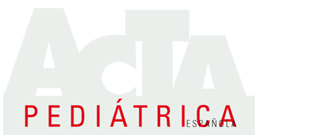Volumen 74 - Número 11 - Diciembre 2016
Publicado en
Formación e información en pediatría
Fuentes de información bibliográfica (XXI). Revistas biomédicas: una visión de su «historia clínica» (y II)
Source of bibliographic information (XX). Biomedical journals: a vision of his “medical record” (and II)
J. González de Dios1, C. Ochoa-Sangrador2, M. González Muñoz3, A. Alonso-Arroyo4,5, R. Aleixandre-Benavent51Servicio de Pediatría. Hospital General Universitario de Alicante. Departamento de Pediatría. Universidad «Miguel Hernández». Alicante. 2Servicio de Pediatría. Hospital «Virgen de la Concha». Zamora. 3Departamento de Odontopediatría. Facultad de Medicina y Odontología. Universidad de Valencia. 4Departamento de Historia de la Ciencia y Documentación. Facultad de Medicina y Odontología. Universidad de Valencia. 5Unidad de Información e Investigación Social y Sanitaria (UISYS). Universidad de Valencia-CSIC. IHMC «López Piñero». Valencia
Publicado en
Formación e información en pediatría
Fuentes de información bibliográfica (XVIII). Pediatría basada en la evidencia y bases de datos de agencias de evaluación de tecnologías sanitarias
Sources of bibliographic information (XVIII). Evidence-based paediatrics and database of health technology assessment agencies
J. González de Dios1, M. González Muñoz2, C. Buñuel-Álvarez3, P. González Rodríguez4, R. Aleixandre-Benavent51Servicio de Pediatría. Hospital General Universitario de Alicante. Departamento de Pediatría. Universidad «Miguel Hernández». Alicante. 2Departamento de Odontopediatría. Facultad de Medicina y Odontología. Universidad de Valencia. Valencia. 3Pediatría Atención Primaria. Àrea Bàsica de Salut Girona-4. Institut Català de la Salut. Girona. 4Pediatría Atención Primaria. Centro de Salud Algete. Madrid. 5UISYS, Unidad de Información e Investigación Social y Sanitaria. Universidad de Valencia-CSIC. IHMC López Piñero. Valencia
Publicado en
Formación e información en pediatría
Fuentes de información bibliográfica (XVII). Pediatría basada en la evidencia y bases de datos de guías de práctica clínica
Sources of bibliographic information (XVII). Evidence-based paediatrics and database of clinical practice guidelines
J. González de Dios1, J. Ruiz Canela2, C. Buñuel Álvarez3, P. González Rodríguez4, R. Aleixandre Benavent51Servicio de Pediatría. Hospital General Universitario de Alicante. Departamento de Pediatría. Universidad «Miguel Hernández». Alicante. 2Servicio de Pediatría de Atención Primaria. Centro de Salud «Virgen de África». Sevilla. 3Servicio de Pediatría de Atención Primaria. Àrea Bàsica de Salut Girona-4. Institut Català de la Salut. Girona. 4Servicio de Pediatría de Atención Primaria. Centro de Salud Algete. Madrid. 5Unidad de Información e Investigación Social y Sanitaria (UISYS). Universidad de Valencia-CSIC. IHMC «López Piñero». Valencia
Publicado en
Formación e información en pediatría
Fuentes de información bibliográfica (XVI). Pediatría basada en la evidencia y bases de datos de revisiones sistemáticas
Sources of bibliographic information (XVI). Evidence-based pediatrics and database of systematic reviews
J. González de Dios1, A. Balaguer Santamaría2, C. Buñuel-Álvarez3, P. González Rodríguez4, R. Aleixandre-Benavent51Servicio de Pediatría. Hospital General Universitario de Alicante. Departamento de Pediatría. Universidad Miguel Hernández. Alicante. 2Facultad de Medicina y Ciencias de la Salud. Departamento de Pediatría. Universitat Internacional de Catalunya. Barcelona. 3Servicio de Pediatría de Atención Primaria. Àrea Bàsica de Salut Girona-4. Institut Català de la Salut. Girona. 4Servicio de Pediatría de Atención Primaria. Centro de Salud Algete. Madrid. 5UISYS, Unidad de Información e Investigación Social y Sanitaria. Universidad de Valencia-CSIC. IHMC López Piñero. Valencia
Publicado en
Formación e información en pediatría
Fuentes de información bibliográfica (XV). Pediatría basada en la evidencia y metabuscadores de MBE
Sources of bibliographic information (XV). Evidence- based pediatrics and search engines of MBE
J. González de Dios1, C. Buñuel-Álvarez2, P. González Rodríguez3, A. Alonso Arroyo4, R. Aleixandre-Benavent51Servicio de Pediatría. Hospital General Universitario de Alicante. Departamento de Pediatría. Universidad «Miguel Hernández». Alicante. 2Servicio de Pediatría de Atención Primaria. Àrea Bàsica de Salut Girona-4. Institut Català de la Salut. Girona. 3Servicio de Pediatría de Atención Primaria. Centro de Salud Algete. Madrid. 4Departamento de Historia de la Ciencia y Documentación. Universidad de València. 5UISYS, Unidad de Información e Investigación Social y Sanitaria. Universidad de Valencia-CSIC. IHMC López Piñero. Valencia
Publicado en
Formación e información en pediatría
Fuentes de información bibliográfica (VIII). Las bibliotecas digitales y virtuales en pediatría
Sources of bibliographic information (VIII). The digital and virtual libraries
C. Navarro-Molina1,2, J. González de Dios3, M. Bolaños Pizarro1,2, A. Alonso Arroyo1,2, R.l. Aleixandre Benavent21Departamento de Historia de la Ciencia y Documentación. Universidad de Valencia. Valencia. 2Unidad de Información e Investigación Social y Sanitaria-UISYS. Universidad de Valencia. CSIC. Valencia.3Servicio de Pediatría. Hospital General Universitario de Alicante. Departamento de Pediatría. Universidad «Miguel Hernández». Alicante














